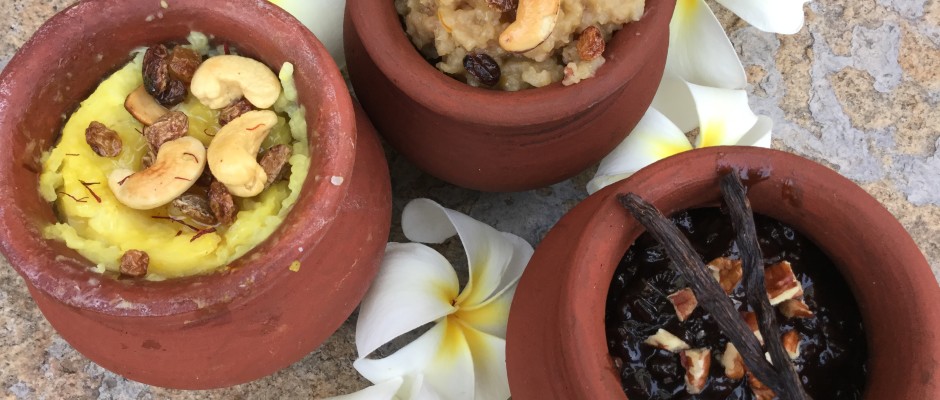Hindu metro plus , Organic heirloom rice pongal
A week or so after the New Year is when one can feel the slight shift in temperature. The biting cold of the tamil month of Margazhi wanes ,signifying the onset of the Thaii maasam . This is when a big chunk of South of India celebrates the harvest festival. The significance of this festival lies in showing gratitude to the sun as it begins it’s journey in the northward direction . Rice is cooked outdoors on a wood fire with the pots placed facing East, in view of the rising sun. The cooked grains are then flavoured with different kinds of natural sugar before being offered to the divine. This sweet rice which we refer to simply as “Pongal” is what the festival is named after.
The markets too wear a festive look. Tall ,purple poles of sugarcane , the thin sprigs of white dotted poola poo , fresh turmeric bulbs and leaves , newly turned out terracotta pots and seasonal flowers are available at every corner and by lane. It’s a time of the year that I look forward to with much happiness. Not only does it give me the chance to cook outdoors but it also reminds me to be immensely thankful for all that the earth has given us.
This year,the Pongal festival has gotten that much more meaningful. Having had the opportunity to interact with farmers,organic experts and agriculturists ,it has made me acutely aware of the need to preserve our farm lands. That thought process is what led to understanding the importance of rice conservation. Rice being the staple diet of South Indians ,signifies a year filled with prosperity , especially for the farmers.
Each household makes many varieties of this sweet rice. Our family favours the sakkarai pongal made with natural jaggery and the kalkandu saadham made with milk and white sugar candy. This year however I thought why not try a pre-pongal experiment with other kinds of organic rice. In addition to the commonly used raw rice,my shopping list also comprised of black sticky rice and red rice. Black sticky rice is very popular in Thailand . It’s served with coconut milk and slices of mango which is to die for ! Very similar to that is our own kavunarisi .It’s used extensively in Chettinad cuisine. Red rice is a partially hulled rice. Both these varities have a delicious nutty flavor as well as texture. They are also high in fibre , high on nutrients and are a much more complex carbohydrate than white rice. So those are facts to feel good about rather than guilty when tucking into a bowl of delicious pongal !
The first step to making any pongal is to wash the grains of rice thoroughly, several times. That water is what is used to fill the pongal pot before lighting the fire. Having decided to stick to cooking in mud pots, I was surprised at how quickly the red and black rice cooked. The mud pots do a fantastic job of retaining the heat long after the fires quiet down to just glowing embers.The black rice cooks to a gluey consistency ,yet retains a bite. The colour goes from a solid black to a glossy purplish black. I decided to pair this with karupatti , the rich black jaggery that is known for it’s colour and nutrients.The heat turned the jaggery into a molten dark, thick liquid which immediately enveloped the rice grains ,resulting in a velvety, sticky dish of sweet rice. This rice had to be infused with an aromatic that was befitting of it.Scrapings of fresh vanilla bean seeds were chosen to match the rice in colour and complemented it by adding the perfect flavor. A final garnish of toasted pecan and walnuts completed my experimental black rice pongal.
The white rice pongal (kalkandhu saadham) is a traditional recipe passed on from my grandmother’s home. Golden,creamy and laced with home made ghee,this one is hard to resist.A generous quantity of milk and powdered sugar candy is added to the cooked rice.Then, fine strands of pure saffron give it that appetizing hue.
The red rice pongal is garnished like the white kalkandu saadham with fried cashewnuts and raisins. To retain the earthy colour of the rice , a paler jaggery was used for sweetness. This pre-pongal trial of using other un-polished rice varieties made me realize the wealth of dietary options available to us. The mud pots too were very easy to manage on the stove and added much joy to the whole process. The smaller ones are perfect for cooking as little as half a cup of rice and are great for serving from the hob to the table.
In recognizing and choosing other rice grains ,we are not only gifting ourselves a more healthy lifestyle but we are also doing our part in preserving the many heirloom rice grains that will help sustain our lands and those that live off it. Having made such a successful start ,there is no doubt at all that these high fibre rice grains will now be a permanent feature in my future culinary forays. I am eagerly awaiting Pongal morning, to cook them all over again !
I do hope that each one of you reading this post will be inspired to experiment with our forgotten rice grains and do your bit to get our agricultural lands back on track. Besides,the benefits to our physical and mental well-being ,is an added bonus !
Sources for organic rice varieties
Bio basics – various varieties of un polished rice , including the black sticky rice. Home delivery option available in Coimbatore 9677640246 ,9788065245
Orga organic store at Race Course



No comments yet.